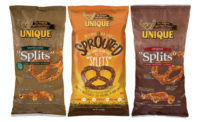2019 State of the Industry: Balancing indulgence and health in foodservice
Top snack and bakery dayparts offer strategic opportunities for R&D inspiration

The current state of snacks and bakery in foodservice reflects the “have your cake and eat it, too” polarity of today’s consumers. We dine out to treat ourselves, yet we still have a nagging sense of responsibility to improved health and wellness.
The recent Global Indulgence Study from Culinary Visions, Olson Communications, Chicago, delves into the psychology of choices made by consumers trying to balance healthfulness and indulgence when dining away from home:
- 86% agree that dining out is a time to treat themselves
- 78% agree that indulgence has to be worth the splurge
- 71% agree that they enjoy the meal without worrying about whether or not it’s good for them
- 64% order an indulgent dessert because they like to treat themselves when dining out
- 58% prefer ordering desserts enjoyed as a child
- 40% are willing to pay more for desserts with brand-name ingredients
“Consumers dine out with specific goals to enjoy themselves, treat themselves and sample things that they do not how to make at home,” says Sharon Olson, executive director, Olson Communications. “Restaurants need to understand that consumers dine out to enjoy themselves, and the experience has to be worth the splurge.”
Yet according to Mintel’s March 2019 “Healthy Dining Trends” report, more diners are open to trying healthy menu items, younger demographics like millennials and Generation Z are more tied to wholesome and clean eating when dining out, and people focusing on health often find that dining out is a challenge.
In order to develop sound strategies for snack and bakery foodservice product development, it makes sense to dig deeper into opportunities within key markets and dayparts.
Breakfast
“All-day breakfast continues to be a focus, as well as protein,” says Matt Gennrich, senior food technologist, R&D bakery applications, Cargill, Minneapolis. “Protein has two facets: increased protein levels overall, and the substitution of plant protein for animal protein.”
Breakfast is often a daypart where better-for-you options can get more traction. “In breakfast items such as breakfast sandwiches, burritos and other bakery products, there is plenty of space to lower sodium levels,” says Janice Johnson, Ph.D., food science lead, Cargill Salt. “Reformulating with potassium chloride, or another sodium-reduction solution, will continue to be important area for operators to explore.”
Breakfast often means convenience. “We see the popularity of breakfast wraps and burritos that can be picked up on a drive-thru and eaten with one hand while commuting to work or sitting at the desk,” says Matthew Bennett, director of strategy & business development, Ingredion Incorporated, Westchester, IL.
“Corn flour brings plenty of benefits to baked goods and tortillas,” says Keyla Rodriguez, technical service manager, starches, sweeteners and texturizers, Cargill. It’s gluten-free and can support claims related to whole grain and fiber, she notes. “In the breakfast space, you see that reflected in the growth of menu items like gluten-free and whole-grain wraps and breakfast burritos, all made with corn flour.”

Sandwiches
“According to Datassential, gluten-free has 30 percent menu penetration. And in a proprietary study that Ingredion conducted that focused on tortillas, 27 percent of consumers perceived gluten-free tortillas as higher-quality than traditional tortillas,” says Ricardo Rodriguez, marketing manager, bakery & confectionary, Ingredion Incorporated, Bridgewater, NJ.
Foodservice menus have embraced the tortilla, notes Gennrich. “Ethnic fusion—think Seoul tacos—remains popular.”
Ethnic flavors and concepts continue to grow, says Zach Gall, marketing manager for foodservice, Ingredion Incorporated, Englewood, CO. He points to menu items like bánh mì (Vietnam, made with baguettes), empanadas (South America) and katsusando (Japan, made with Japanese milk bread).
“We see the sandwich carriers like tortillas and buns mainly serving two purposes in a menu item: they can either add authenticity (think artisan bread or brioche) or add a health halo (think gluten-free, ancient grains or organic),” says Bennett.
Better-for-you ingredients are in demand, says Olga García, milling marketing manager, Bunge North America, St. Louis. She suggests plant proteins, grains, fruits, fiber and seeds for buns, tortillas and other sandwich carriers. “Ancient grains such as quinoa, sorghum and millet can be added to masa products for wraps, tortillas, nachos and taco shells.” The ingredients can be customized to meet any functional requirement, such as color and granulation, or with special gums or enzymes to help achieve a desired taste, texture and shelf life, she notes.
“Producers of tortillas have gotten very creative and inventive on looking at new ingredients,” says Rick Cummisford, director of quality control, Columbus Vegetable Oils, Des Plaines, IL. This includes replacing PHOs without changing texture, pliability and stickiness. He notes that tortilla bakers have found significant success in using palm-based and interesterified shortenings, often with an added emulsifier in the shortening to provide the right functionality.
A critical component of fried snack and bakery production is using high-stability oils that offer a cost-efficient frying solution with clean taste that extends fry life without sacrificing functionality or performance, says Carson Callum, market manager, Grains & Oils, Corteva Agriscience, agriculture division of DowDuPont, Indianapolis. High-stability oils from Corteva Agriscience are grown under an identity-preservation program, which protects the quality of the crop and its oil, allowing for full traceability and transparency.
Desserts
Desserts must always convey varying degrees of indulgence. “We see the foodservice space providing sensory cues to entice consumers, such as ‘triple chocolate’ or ‘tres leches,’” says Gretchen Hadden, marketing communications manager, Cargill Cocoa & Chocolate North America.
Flavor innovation is important. “The often shareable, experience-oriented nature of dessert makes consumers more open to trying innovative flavors,” says Hadden. She points to flavors like matcha, lavender, guava and cayenne to build intrigue. “Global dessert flavors are also making waves on U.S. dessert menus, with flavors such as dulce de leche and Mexican chocolate popping up. While flavor exploration is indeed stretching into new territory, they are often balanced with a flavor that is beloved and classic, such as chocolate or vanilla, which helps to balance the adventure with some familiarity.”
Nostalgia is also a strong influencer, says Hadden, noting that s’mores flavor may pop up in pie, and cereal flavors in doughnuts.
A balanced approach toward dessert can also find an audience. “Hot areas within foodservice innovation include free-from, plant-based and healthful versions of traditionally indulgent desserts, such as cheesecakes, cakes and pies, which incorporate ingredients including almond flour, almond milk and plant-based oils,” says Harbinder Maan, associate director, trade marketing and stewardship, Almond Board of California, Modesto, CA. “Traditionally indulgent flavor combinations like chocolate and nuts are being adapted in desserts to offer consumers a seemingly rich, yet better-for-you, option.”
Maan suggests almond flour for crunchy dessert crusts and toppings, and almond butter in gluten-free desserts. Almond butter is also a natural fit for cheesecakes and layered cakes, she says.
And we must factor in the desires of younger generations when designing desserts. Millennials are the largest and most-influential consumer group in the U.S., says Elizabeth Ortiz, marketing specialist, Boston Baking Inc., Boston. “This group is highly focused on eating better-for-you items, as well as reduced portions. For example, mini fruit pies are perfect when using real fruit with clean-label crusts.” She suggests a combination of indulgence and preservative-free ingredients.
Ortiz notes that millennials are also gravitating toward nostalgic desserts. “For example, a New England classic, the whoopie pie, is a portable cake that is gaining momentum out West.” It’s conveniently grab-and-go and can come in a wide variety of flavors, including seasonal options.
“Consumers are becoming increasingly aware of what they are eating. They are also more creative and want to try traditional baked goods with different flavors, particularly ethnic flavors,” says John Fisher, process improvement and R&D manager, Boston Baking. “With the use of the right ingredients, we can produce desserts that fit the needs of the consumer without compromising on taste.”
Looking for a reprint of this article?
From high-res PDFs to custom plaques, order your copy today!





